Lung Cancer: The Leading Cause of Cancer Death

Lung cancer has emerged as the leading killer of men and women with invasive cancer, affecting husbands and wives, friends and neighbors, and causing suffering for many families. In the United States, lung cancer overtook breast cancer as the leading cause of cancer deaths in women in 1987. Lung cancer deaths account for a quarter of all American cancer deaths, killing more people every year than prostate, breast, and colon cancer combined. Nearly 160,000 Americans died from lung cancer in 2017.
What Causes Lung Cancer?

The exact cause of lung cancer is still being investigated. Certain risk factors have been shown to play a part in causing cells to become cancerous. Risk factors for lung cancer include smoking, exposure to air pollution, and genetics.
Does Smoking Cause Lung Cancer?
The major cause of lung cancer in men and women is cigarette smoking. In 1876, a machine was invented to make rolled-up cigarettes and thus provided cheap tobacco products to almost anyone. Before that time, lung cancer was relatively rare. After the invention of cigarette mass production, smoking dramatically increased, and so did lung cancer. Currently, about 90% of all lung cancers are related to smoking. Radon gas, pollution, toxins, and other factors contribute to the remaining 10%.
Cigarettes and cigarette smoke contain over 70 cancer-causing chemicals (carcinogens). Some of the carcinogens found in cigarette smoke include:
- Lead (a highly poisonous metal)
- Arsenic (an insecticide)
- Cadmium (a battery component)
- Isoprene (used to make synthetic rubber)
- Benzene (a gasoline additive)
Cigar smoke is heavy in tobacco-specific nitrosamines (TSNAs), which are considered particularly cancerous.
Lung Cancer and Cilia
Cigarette smoke damages and sometimes kills hair-like projections on airway cells. These are known as cilia. The cilia normally sweep out toxins, carcinogens, viruses, and bacteria. When cilia are damaged or destroyed by smoke, all of these items may accumulate in the lungs and may cause problems such as infections and lung cancer.
Lung Cancer Symptoms

Unfortunately, lung cancers often have either no early symptoms or nonspecific early symptoms that people may dismiss. About 25% of people with lung cancer and no symptoms are diagnosed after having a chest X-ray or CT during a routine test or as a procedure for other problems. Lung cancer symptoms that may be detected are included below.
Lung Cancer Symptoms
- Cough (chronic, recurrent)
- Fatigue
- Weight loss
- Shortness of breath or wheezing
- Coughing up phlegm that contains blood
- Chest pain
Three Common Lung Cancer Screening Methods
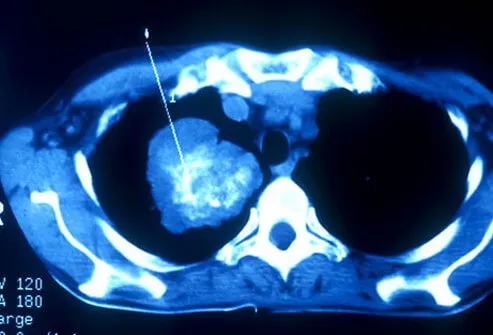
Screening for lung cancer is usually accomplished using three methods.
Physical Exam
A physical exam will look for signs of wheezing, shortness of breath, cough, pain and other possible signs of lung cancer. Depending on the advancement of the cancer, other early signs of lung cancer symptoms may include a lack of sweating, dilated neck veins, face swelling, excessively constricted pupils, and other signs. The physical exam will also include the patient's history of smoking and a chest X-ray.
Sputum Cytology Exam
A sputum cytology exam involves a microscopic examination of a patient's mucus (sputum).
Spiral CT Exam
This method of CT scanning builds a detailed image of the body's internal workings. Inside a spiral CT machine, detailed images are taken of the relevant parts of the patient's body. Those images are then linked to an X-ray machine to create 3D images of the patient's internal organs. These images may reveal potentially cancerous tumors.
A study by researchers suggested that people aged 55 to 74 years old who had smoked at least one pack of cigarettes a day for 30 or more years may benefit from a spiral CT study of the lungs.
Lung Cancer Diagnosis

If the screening tests suggest a person has lung cancer, definitive diagnostic tests may be done by a pathologist. The pathologist will examine the patient's lung cells in sputum, phlegm, or from a biopsy sample to type and stage the lung cancer.
Lung Cancer Biopsy

As stated previously, a tissue sample taken from the patient's suspected cancer is usually the best method to establish a definitive lung cancer diagnosis. In general, lung biopsies are obtained by either needle biopsy, a lung bronchoscopy technique, or by surgical removal of tissue. Many other tests may be done to get more information about the cancer's spread.
See the following slides for types of lung cancer and lung cancer stages, including stage IV lung cancer.
Types of Lung Cancer
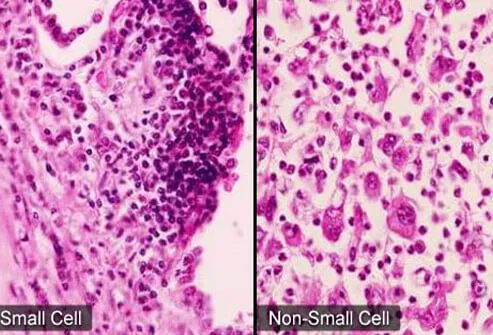
There are only two major types of lung cancers: small cell lung cancer and non-small cell lung cancer. Less than 5% of lung cancer tumors will take the form of a carcinoid tumor, while other cancerous tumors are even more rare, including adenoid cystic carcinomas, lymphomas, and sarcomas. Although cancer from another part of the body may spread to the lungs, these are not categorized as lung cancer.
Non-Small Cell Lung Cancer
Non-small cell lung cancers are the most common type of lung cancer. These cancers account for about 90% of all lung cancers and are less aggressive than small cell lung cancers, meaning they spread to other tissues and organs more slowly.
Small Cell Lung Cancer
Small cell lung cancer, also called oat cell lung cancer, accounts for about 10% of all lung cancers. This form of cancer tends to spread quickly.
Lung Cancer Stages: 0-4
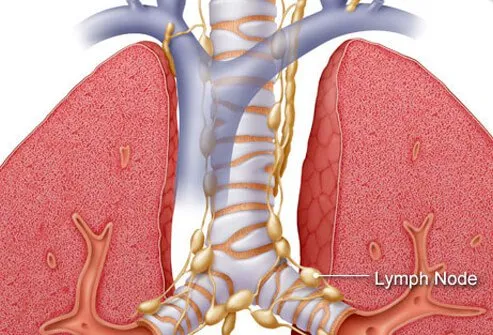
After the type of lung cancer is determined, the type is then assigned a lung cancer stage. The stage indicates how much the cancer has spread in the body (for example, to the lymph nodes or to distant organs like the brain). Stages for non-small cell lung cancers are different from small cell lung cancers. The stages listed below are taken from the National Cancer Institute's lung cancer staging information; there are other systems that stage differently (SEER system by American Cancer Society):
Small Cell Lung Cancer Stages
Limited stage: In this form, small cell lung cancer is limited to one side of the chest, typically in the lungs and lymph nodes. About one in three people with small cell lung cancer have limited stage cancer upon the first diagnosis.
Extensive stage: This refers to small cell lung cancer that has spread throughout one lung, spread into both lungs, to lymph nodes on the other side of the chest or to other body parts. About two in three people with small cell lung cancer have extensive stage cancer upon first diagnosis.
Non-Small Cell Lung Cancer Stages
Occult (hidden) stage: In this stage, cancer cells appear in a sputum cytology exam or other test, though no tumor location can be found.
Stage 0 (carcinoma in situ): In this lung cancer stage, cancer cells are only found in the top layer of cells lining air passages and has not crept deeper into the lungs or spread beyond the air passages.
Stage I: A small lung cancer tumor (less than 3 centimeters across) is discovered, but has not spread to surrounding lung membranes, lymph nodes, or the main bronchial branches of the lungs.
Stage II: There are several ways that stage II lung cancer may be diagnosed. One is that the lung cancer has spread to lymph nodes near the lungs.
- Stage IIA: If the tumor is between 3 centimeters and 5 centimeters, the lung cancer is defined as stage IIA. Other factors can lead to this classification as well.
- Stage IIB: If the lung cancer tumor is between 5 centimeters and 7 centimeters, it is categorized as Stage IIB. Other factors can lead to this classification as well.
Stage III: As in stage II lung cancer, stage III has several definitions. One is that the lung cancer is found in both the lung and lymph nodes in the middle of the chest. Stage III lung cancer is divided into two subsets.
- Stage IIIA: This defines a lung cancer that has spread on the same side of the chest from where it started.
- Stage IIIB: This defines a lung cancer in which the cancer has spread to either the opposite side of the chest or above the collar bone.
Stage IV: This is the most advanced stage of lung cancer. The cancer can be any size, but two of these three things have happened:
- The cancer has spread to the opposite lung from where it began.
- Cancer cells have been discovered in the fluid surrounding the lung.
- Cancer cells have been discovered in the fluid surrounding the heart.
Lung Cancer Survival Rates

This disease is difficult to detect in its early stages, and treatments for late-stage lung cancer provide a poor prognosis. Survival rates vary depending on the cancer type. According to the American Cancer Society, over five years the average survival rate is 24% across all stages of non-small cell lung cancer. The same average for small-cell lung cancer is 6%. The 5-year survival rate for both types is higher if diagnosed and treated while the cancers are in the localized or regional SEER stages; however, distant stage lung cancer stages are worse.
Surgery

Early stage (stage 0 or even some stage I) cancer treatment of non-small cell lung cancer may benefit from surgery. Part or all of a lung segment that contains the cancer may be removed; in some individuals, this may result in a cure. However, many patients still undergo chemotherapy, radiation therapy or both to kill any cancer cells not removed by surgery. Because small cell lung cancers are almost never diagnosed early, surgery (and other treatments) may prolong life but rarely, if ever, result in a cure.
Advanced Lung Cancer Treatment
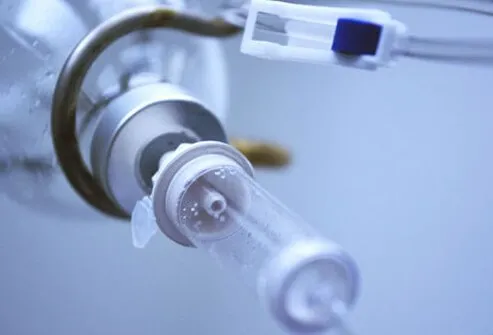
Most small cell and non-small-cell lung cancers are treated with chemotherapy; they may also be treated with radiation therapy and surgery. In many patients with advanced disease, these methods may be used together, depending on the patient's condition and recommendations by their cancer doctors.
Targeted Lung Cancer Therapies

Some therapies known as targeted therapies are designed to prevent or stop lung cancer cells from growing by targeting the new blood vessels that are needed to allow the cancer cells to survive and grow. Other treatments target growth and multiplication of lung cancer cells by interfering with chemical signals required by growing or multiplying cancer cells.
Clinical Trials for Lung Cancer

In addition to targeted therapies, there are several clinical trials that a person may qualify for. Some may be available in your hometown. These clinical trials have patients try the newest potentially helpful therapeutic methods and drugs to combat lung cancers.
Life After Lung Cancer Diagnosis

After a diagnosis of lung cancer, it is not unusual to feel depressed and upset. However, research is ongoing, and it is possible to survive and extend your life with treatment. Even with the diagnosis, there is evidence that people who develop a healthy lifestyle and stop smoking do better than those who do not change.
Lung Cancer and Secondhand Smoke

Tobacco smokers put others at risk of developing lung cancer. A nonsmoker (wife, child, significant other) who lives with a smoker has a 20% to 30% increase in risk of developing lung cancer due to exposure to smoke concentrations in their local environment.
Lung Cancer and Work Exposures
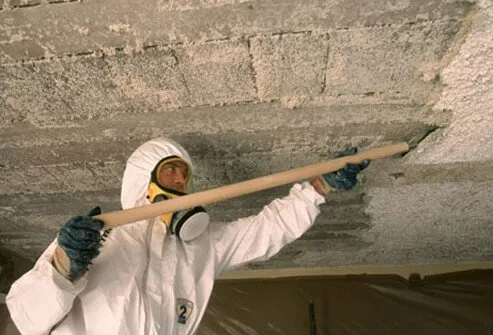
Although smoking is the most common cause of lung cancers, other compounds and chemicals can increase your risk of lung cancer too. Such agents as asbestos, uranium, arsenic, benzene, and many others increase the risk for developing lung cancers. Exposure to asbestos may cause lung cancer (mesothelioma) many years after the initial exposure so people may be at risk for lung disease for decades (10 to 40 years).
Lung Cancer and Radon Gas
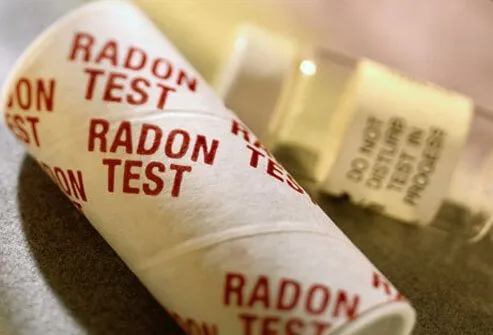
Another chemical, radon gas, is the second leading cause of lung cancer. It occurs naturally but can seep into homes and collect in basements and crawl spaces. It is colorless and odorless but can be detected with relatively simple and inexpensive test kits. Smokers exposed to this gas have a higher risk of developing lung cancer than nonsmokers.
Lung Cancer and Air Pollution

Some investigators suggest air pollution contributes to the development of lung cancers. Several studies present data that airborne pollutants like diesel exhaust may cause some people to develop lung cancers. Researchers estimate that about 5% of lung cancers are due to air pollutants.
Increased Risk Factors for Lung Cancer

Although much is understood about lung cancers, there are still many things and situations that are unclear. For example, it is unknown why some families have a history of lung cancer despite no clear risk factors. The same is true for some patients who develop lung cancers with no clear risk factors. Drinking water that has high arsenic concentrations may increase lung cancer risk but how the process happens is not clear. In addition, the reason why adenocarcinoma in the lungs is more common in nonsmokers than smokers remains unknown.
Lung Cancer Prevention
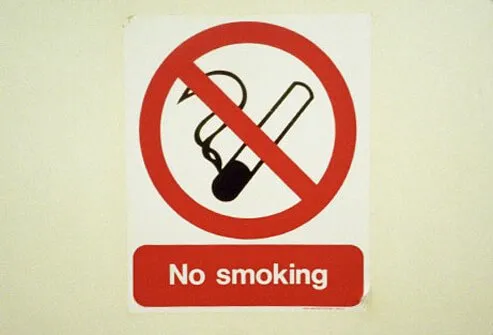
For most lung cancers, prevention is possible if a person never smokes and avoids second-hand smoke. For smokers who quit, within 10 years their risk of getting lung cancer drops to about the same risk as if they had never smoked. Avoiding other risk factors (for example, certain chemicals or compounds like benzene or asbestos or air pollution) may also prevent some people from developing lung cancers.
Additional Information on Lung Cancer
For more information about Lung Cancer, please consider the following:
Lung Cancer: Early Signs, Symptoms, Stages
This tool does not provide medical advice. See additional information: 
© 1996-2024 WebMD, LLC. All rights reserved.
